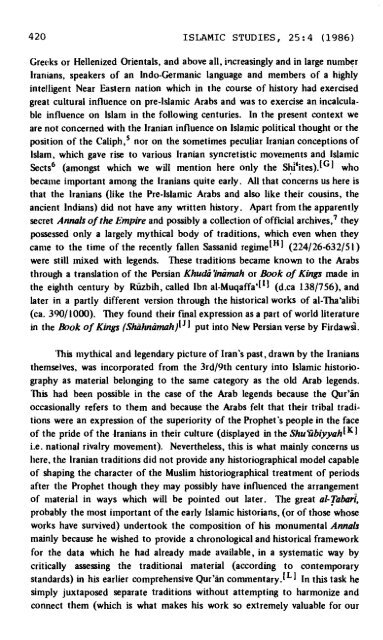ISLAMIC & WESTERN HISTORIOGRAPHY
ISLAMIC & WESTERN HISTORIOGRAPHY
ISLAMIC & WESTERN HISTORIOGRAPHY
You also want an ePaper? Increase the reach of your titles
YUMPU automatically turns print PDFs into web optimized ePapers that Google loves.
4 20 <strong>ISLAMIC</strong> STUDIES, 25 : 4 (1986)<br />
Grecks or Hellenized Orientals, and above all, irlcreasingly and in large number<br />
Iranians, speakers of an Indo-Germanic language and members of a highly<br />
intelligent Near Eastern nation which in the course of history had exercised<br />
great cultural influence on pre-Islamic Arabs and was to exercise an incalculable<br />
influence on Islam in the following centuries. In the present context we<br />
are not concerned with the Iranian influence on lslamic political thought or the<br />
position of the caliph,' nor on the sometimes peculiar Iranian conceptions of<br />
Islam, which gave rise to various Iranian syncretistic movements and Islamic<br />
sects6 (amongst which we will mention here only the ~hhtes).~'] who<br />
became important among the Iranians quite early. All that cdncerns us here is<br />
that the Iranians (like the Pre-Islamic Arabs and also like their cousins, the<br />
ancient Indians) did not have any written history. Apart from the apparently<br />
secret Annals of the Empire and possibly a collection of official archives,' they<br />
possessed only a largely mythical body of traditions, which even when they<br />
came to the time of the recently fallen Sassanid regimeIH1 (224126-632151)<br />
were still mixed with legends. These traditions became known to the Arabs<br />
through a translation of the Persian Khua5'i~mah or Book of Kings made in<br />
the eighth century by Riizbih, called Ibn al-~u~affa'['l (d.ca 138/756), and<br />
later in a partly different version through the historical works of al-Tha'alibi<br />
(ca. 390/1000). 'They found their fmal expression as a part of world literature<br />
in the Book of Kings (shiihnrimah)lJ 1 put into New Persian verse by FirdawG.<br />
'Yhis mythical and legendary picture of Iran's past, drawn by the Iranians<br />
themselves, was incorporated from the 3rd19th century into Islamic historio-<br />
graphy as material belonging to the same category as the old Arab legends.<br />
'This had been possible in the case of the Arab legends because the Qur'h<br />
occasionally refers to them and because the Arabs felt that their tribal tradi-<br />
tions were an expression of the superiority of the Prophet's people in the face<br />
of the pride of the .Iranians in their culture (displayed in the ~ hu'iibi~~ah[~<br />
i.e. national rivalry movement). Nevertheless, this is what mainly concerns us<br />
here. the lranian traditions did not provide any historiographical model capable<br />
of shaping the character of the Muslim historiographical treatment of periods<br />
after the Prophet though they may possibly have influenced the arrangement<br />
of material in ways which will be pointed out later. The great al-~aban,<br />
probably the most important of the early Islamic historians, (or of those whose<br />
works have survived) undertook the composition of his monumental Annals<br />
mainly because he wished to provide a chronological and historical framework<br />
for the data which he had already made available, in a systematic way by<br />
critically assessing the traditional material (according to contemporary<br />
standards) in his earlier comprehensive Qur'iin commentary.[L] In this task he<br />
simply juxtaposed separate traditions without attempting to harmonize and<br />
connect them (which is what makes his work so extremely valuable for our
















